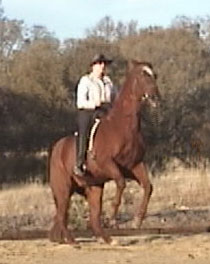|
What is ‘Front to
Back’ Riding?

‘Massaging’ the reins, ‘sponging’ the reins, see-sawing,
using ‘hold & release’, using ‘resistance/counter resistance’ or
other signals to “supple the horse” or cue the horse’s head down
is front to back riding.
Active hand riding is based on the principle that a horse
will change its behavior to make discomfort cease. The horse
learns that when it feels discomfort in its mouth, it can put
its head down and make the discomfort stop. Teaching the horse
to ‘give to the bit’ in response to a cue creates a head set
which has no relevance to the horse’s state of balance,
relaxation or free flow of energy. The dominant, backward action
of the hands is referred to as ‘hand riding’ or riding ‘front to
back’ because it acts on the front end of the horse in an
attempt to influence the rest of the horse’s body. Artificially
positioning the horses head and neck creates tension because it
disrupts the horses balance and freedom of movement.
See: Visual Points
What is ‘Back to
Front’ Riding?


‘Back to front’ riding is when the rider helps the aligned
horse to flow forward with well-timed, full swinging steps that
helps the horse naturally relax and reach for contact. It is
called ‘back to front’ riding because the horse’s energy travels
from its haunches, through its spine, forward to the bit. The
horse’s whole body works harmoniously. Improving the horses
balance and forward flow of energy automatically improves the
horse’s posture and creates an appealing head position. The
horse’s natural head position is a reflection of its way of
going. It gives the rider important feedback on the quality of
the work. Creating a natural head set takes a bit of tact but
with good instruction, it’s not beyond the ability of the
average rider.
|

![]()